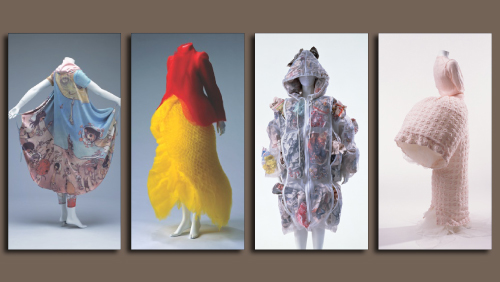By Deanna Duff
Northwest Asian Weekly

From left: Issey Miyake, Junya Watanabe, Kosuke Tsumura, and Rei Kawakubo (Photos from the Seattle Art Museum)
For many people, back-to-school shopping was the last time they seriously considered how clothing impacts identity, but Seattle Art Museum’s newest exhibition may spur new thought.
The museum’s first ever contemporary fashion exhibit, “Future Beauty: 30 Years of Japanese Fashion,” debuts in July and is a compelling reminder that clothes are a statement of art and the individual.
“Some of these are epoch-making pieces,” said Akiko Fukai, director and chief curator of the Kyoto Costume Institute, which put together the exhibit. “It made Western people awaken to the question of, ‘What is beauty?’ The Japanese sense is so different than the Western. It helped some people recognize a new beauty.”
Fukai is a preeminent fashion historian and the driving force behind KCI’s Future Beauty, which originally opened in 2010. The stop in Seattle marks Future Beauty’s U.S. debut. The exhibit tracks the international emergence of Japanese fashion from the 1980s onward, featuring over 100 garments from the last 30 years — some never before seen in the United States.
When considering Seattle to host Future Beauty, Fukai personally visited the city. She was impressed by Seattle’s sensibilities and appreciation of Asian culture, particularly as evidenced by the Seattle Asian Art Museum collection.
“I’m very glad to hold the exhibition here so we can show how Japanese fashion is very contemporary. I think it’s a great collection to have in Seattle,” said Fukai.
The Rise of Japanese Fashion
High fashion became more accessible to mainstream culture during the 1980s. Supermodels gained widespread notoriety and magazines reported updates from Paris and Milan. Japanese designers also rapidly gained prominence on fashion runways.
“They [Japanese fashion designers] debuted in the Paris collections and made the shows very different,” said Fukai. “They used a lot of black and monochrome. The silhouettes were very full — dubbed ‘no form’ at the time. The notion of construction was different. The Japanese use a very flat pattern, which has roots in the traditional kimono, compared to Western designs which use body-fitted patterns.”
Designers such as Comme des Garçons’ Rei Kawakubo, Issey Miyake, Junya Watanabe, and Yohji Yamamoto were leaders in defining the Japanese aesthetic. All are represented in Future Beauty.
In addition to embracing contrasting textures, asymmetry, and deconstructed designs, Japanese fashion houses also staged markedly different runway shows. Models were allowed to wear flats rather than stomping down runways on towering stilettos. The exhibit includes video footage and photography of Japanese runway shows.
“The designers of that time were reacting to the larger social and political climate, including the depression [Japan’s economic downturn in the 1990s],” said Catharina Manchada, SAM’s Jon and Mary Shirley Curator of Modern and Contemporary Art. “Japanese designers were taking a stance and making an aesthetic and value break from the West.”
Favorites of Future Beauty
Many museum exhibitions are a glimpse into a world long-since passed, but Future Beauty resonates many ways in modern life. Some of the designer labels may appear in visitors’ own closets and some pieces include recognizable characters such as Hello Kitty and Astro Boy.
“Every section has pieces that are totally stunning and each is a revelation in its own way,” said Manchada.
The exhibit is divided into four sections: In Praise of Shadows explores materials, textures, and light; Flatness focuses on geometry and volume; Tradition and Innovation considers how items such as kimonos and origami were reinterpreted for fashion; and Cool Japan investigates the present-day influence of street style.
“There are many ‘Wow!’ moments. There is a raincoat (by Kosuke Tsumura) with pouches that you can stuff with recycled paper, silk flowers or colorful stuffing and customize it any way you want. There is a great economy and efficiency behind it because you can use any material either to be stylish or use it practically as insulation,” said Manchada.
The 1997 Body Meets Dress, Dress Meets Body series by Kawakubo of Comme des Garçons is another standout. Double-layered stretch dresses are stuffed with pillow-like pads to create fantastical shapes.
The impact of such art/fashion had worldwide influence. Legendary choreographer Merce Cunningham, a Washington native, collaborated with Kawakubo to create costumes for his dance, Scenario.
“Walking through the show, I want to wear every single one of the garments,” said Manchada whose own fashion education began as a child from her seamstress mother. “I feel so inspired by the creativity on display.”
Fashion Fantasy and Reality
Many Future Beauty pieces seem better suited for the catwalk than the office cubicle. However, the experience invariably encourages visitors to view their everyday wardrobes in a new light.
“People take different things away from show. One thing I hope, though, is that perhaps people will start to dress themselves differently. They’ll feel inspired to combine things in different ways. Clothing is a form of expression and this (exhibit) is about embracing that,” said Manchada.
The sculptural aspects, sophisticated cuts, folds and craftsmanship can be appreciated by all ages and backgrounds. The Cool Japan section is a particular hit with younger audiences thanks to its focus on street fashion and influences such as manga, anime, and Hello Kitty. Family programming is also available. Origami exercises illustrate the art’s impact on Japanese fashion.
The hardest part? Walking away from what is currently Seattle’s most marvelous “walk-in closet.”
“It’s obviously tempting to rush up, take the pieces down and want to try them on. I’m afraid it’s a temptation we’re all going to have to fight!” Manchada said, laughing. (end)
Future Beauty: 30 Years of Japanese Fashion debuts at the Seattle Art Museum on June 27. The show runs until Sept. 8. For pricing, hours, and more information, visit www.seattleartmuseum.org.
Deanna Duff can be reached at info@nwasianweekly.com.



